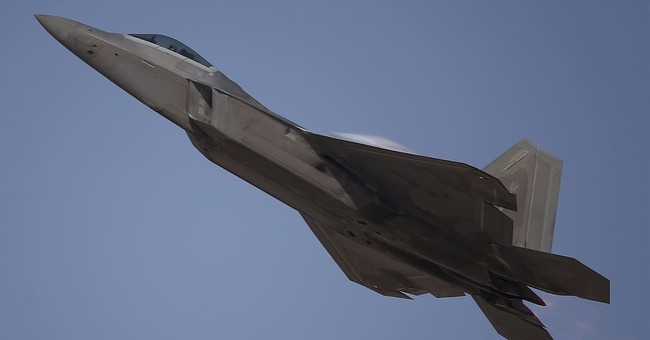A new stealth fighter prototype has taken to the skies, Air Force acquisition chief William Roper casually let it be known on Tuesday.
Move over, F-22 Raptor — there’s a new kid in town.
Well, maybe not quite yet, but also maybe years sooner than anyone expected or even dreamed.
The Air Force “secretly designed, built, and tested” the prototype in just one year, which is unprecedented in recent decades.
Can you say, “Make procurement great again?”
Roper told Defense News earlier this week, “We’ve already built and flown a full-scale flight demonstrator in the real world, and we broke records in doing it.”
Staying otherwise mum on when the world can expect to see the world’s first sixth-generation air superiority jet, Roper added, “All I can say is that the.. test flights have been amazing.”
Officially known at this early date as the Next Generation Air Dominance (NGAD) fighter, the Air Force could not have found a better time to get its procurement mojo back.
Currently, the Air Force’s air superiority fleet consists of just 186 F-22 Raptors and around 450 F-15C/D Eagles.
The more-numerous F-15 platforms, designed back in the early 1970s, would have difficulty surviving — at best — against the air defense systems of near-peer opponents like China and Russia.
There aren’t enough F-22s to go around, which is hard on airframes expected to serve for 40 years or more. All that extra flying ages the platforms more quickly than defense planners accounted for, meaning USAF has got to get its replacement in the air ASAP.

The first F-22 flew in 1997 after nearly 15 years of planning and didn’t enter service until 2005. The last F-22 rolled off the assembly line in 2011. Restarting that line would be prohibitively expensive according to Air Force studies.
Needless to say, getting NGAD up in the air, breaking records in less than a year is far beyond even the most optimistic predictions for the new stealth fighter.
The Air Force is also mum on the capabilities being baked into the NGAD, but we can make a few educated guesses.
Manned or Unmanned?
Yes!
The Air Force’s new heavy bomber currently in development, the B-21 Raider, is being designed from the ground up to operate with or without an aircrew. There’s no reason to believe that the new stealth fighter wouldn’t enjoy the same ability to fly and fight autonomously should the need arise.
Performance
The F-22 that NGAD is meant (we assume) to augment and eventually replace is believed to be the most maneuverable air superiority fighter in existence — or at least the most maneuverable stealth fighter.
NGAD will almost certainly exceed the F-22’s maneuverability while matching its ability to fly faster than the speed of sound without lighting up the afterburners (supercruising).
It’s my personal hope that NGAD will also enjoy a range advantage over the Raptor. We’ve counted too long on having friendly airfields close to the battlespace, and have sacrificed range on both the F-22 and F-35 platforms.
That needs to change and hopefully will with the Air Force’s new stealth fighter.
Stealth
The F-22 is one slippery SOB, able to break the enemy’s “kill chain” in various ways from having a small radar cross-section (stealth), to countermeasures, to super-awareness of the battlespace that allows pilots to avoid danger.
The kill chain is the set of steps required to identify, locate, track, target, and engage (ie, destroy) an enemy plane. Break any link in the chain, and there’s no kill.
NGAD ought to be stealthier than the F-22, and smarter, too.
That brings us to…
Beyond Stealth
While the F-35 Lightning II took too long and cost too much to develop, its performance as the all-seeing “eye in the sky” and its ability to share that information make it the most powerful strike jet that’s ever flown. Every F-35 pilot is essentially an entire AWACS crew.
In other words, if the Raptor is super-aware then the F-35 is hyper-aware.
It’s a huge force-multiplier just having one or two F-35s with its top-secret sensor suite in the air. Again, there’s no reason to think that NGAD won’t be similarly equipped to gather and share data. But unlike the F-35, which is optimized for air-to-ground strike missions, NGAD will probably be a pure enemy jet-killing machine.
Cost
A lot.
But maybe not as much as feared.
The first stealth jets were expensive to maintain and super-expensive to operate. Since the F-117 was developed in secret during the ’70s however, we’ve learned a lot about what works and what doesn’t. Having already paid dearly to earn that knowledge, it’s cheaper to apply it to future platforms like NGAD.
The F-35 was designed with lessons in mind about operational costs, and while it isn’t as stealthy as the F-22, those applied lessons make it cheaper to fly and maintain.
NGAD isn’t just the first sixth-generation jet fighter, it’s also our third-generation stealth jet. As such, it ought to be stealthier than the F-22 and perhaps just as inexpensive (on the new stealth fighter scale, that is) to operate as the F-35.
That’s a win-win-win: We win on lethality, we win on readiness, and we win as taxpayers.
I’ll follow the story of NGAD development just as closely as classification laws allow, so please stay tuned to this space for more.










Join the conversation as a VIP Member